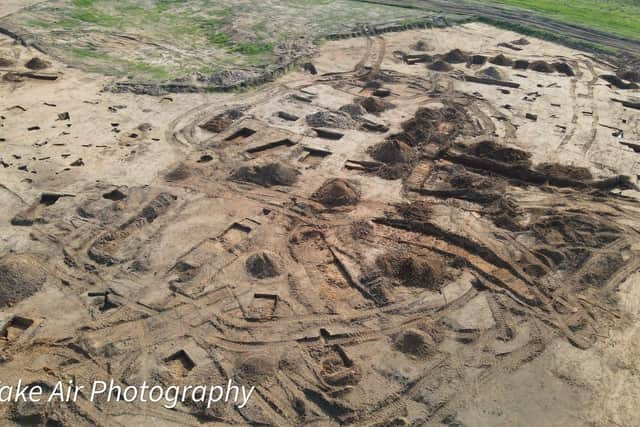Campaigners Save Bourne Hill calling for archeological site and green space in Thornton Cleveleys to be saved from development
and live on Freeview channel 276
The site on Bourne Hill has been found to contain evidence of an Iron Age settlement and later Roman occupation.
Remains of round houses and ceramic items have been found there, thought to date from between 2 BC and 2 AD.
Advertisement
Hide AdAdvertisement
Hide AdThere are even some theories that the site is the location of Setantii, an important port on the west coast, referred to in Roman times by Ptolemy, and whose exact location has never been pinned down by historical researchers.


But campaigners say they are concerned that the archeological site, and the vibrant ecological green space around it, will be destroyed by the housing project from Eccleston Homes which is on the same piece of land.
The application to build the new estate was approved by Wyre planning committee in June but a number of conditions were stipulated - including the preparation of an archeological report - and building cannot commence until these conditions have been met.
Eccleston commissioned Oxford Archaeology North (OAN) to conduct an archeological survey, with OAN visiting the site in September.
What Save Bourne Hill says
Advertisement
Hide AdAdvertisement
Hide AdCampaign group Save Bourne Hill, which has 2,000 members on its Facebook site, says it wants to protect the archeology and ecology on the site by halting the building project – before it is too late.
The group said in a statement this week: “We are just a group of ordinary local people and families with one thing in common: we want a stop to the destruction of green space and nature in the place we live.
"Bats and birds rely on the trees, shrubs and grassland, including wintering geese and swans of international importance, as well as local nesting birds and the land has waterways where Great Crested Newt and Water Voles are both protected.
"Some of their precious habitat has already been lost and all of it will be disturbed or totally destroyed by construction
Advertisement
Hide AdAdvertisement
Hide Ad"We invite everyone, everywhere, to join together with us, to save our disappearing natural world, starting right now, at home, wherever we live. Together we can save it.”
The group says that developers across the land are trying to rush through their projects in a bid to beat the deadline for the law on Biodiversity Net Gain, which was due to come into force in November 2023, but has been delayed until April 2024.
This law should force developers to pay for measures to guarantee that every construction scheme creates more biodiversity than it destroys.
What the archaeologists found
Paul Dunn, lead archaeologist from OAN, told the BBC about the site: "Unlike other Iron Age sites in Lancashire we have found ceramics and pottery in Bourne Hill.
Advertisement
Hide AdAdvertisement
Hide Ad"Like other Iron Age excavations in the county the dig at Thornton, had revealed round houses with their surrounding ditches, but the discovery of Iron Age bowls and Roman pottery marked it out from other excavations.
"It is a significant site because there are signs of a long occupation from the Iron Age to Roman Britain."
What Wyre Council says
Wyre Council said in its latest statement: “ We have held discussions with the developer to reiterate that work cannot commence until all conditions are discharged and we would like to reassure the public, once more, that all work so far has proceeded in accordance with the standard process for managing archaeological sites in the planning process. “The council has relied, as it always does, on the expertise of a specialist archaeology planning officer from Lancashire County Council’s (LCC) Historic Environment Team throughout this process.”
Eccleston Homes were approached for a comment.